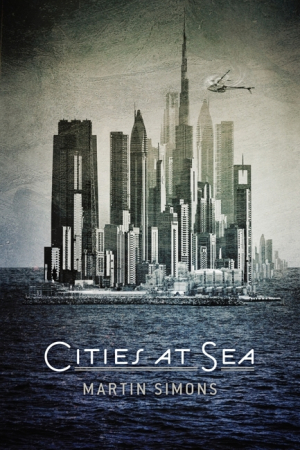
Cities at Sea
This dystopian retelling of The Little Mermaid integrates ingenious futuristic technology.
Can mermaids and genetic engineering coexist? Set three thousand years into the future, with most of Earth under water and the majority of people living on floating city-rafts, Martin Simons’s Cities at Sea explores this question. The story works best when the author integrates futuristic elements into the story.
Seventeen-year-old Sal complains to the captain of the raft of Sydney, Australia, on which she lives, “Life [here] is good but dull. Nothing very exciting ever seems to happen.” Like every other inhabitant on every other raft, she knows how to navigate a ship. However, in a world constantly monitored by cameras, Sal harbors a secret desire to swim among the fish. When a renowned scientist named Jezzy offers to genetically alter the teenager to pave the way for a new race of “sea sprites” adapted to aquatic life, Sal wonders whether to pursue her dream or stay with the life she knows. This ingenious high-tech twist on The Little Mermaid combines the past, present, and future, the timely and the timeless, exploring the hot topic of climate change while examining the age-old theme of following one’s heart.
Simons excels at world building. He immediately plunges readers into a thrilling world of robo-cars, constant monitoring, and carefree sex. It’s a world in which everyone’s desires are satisfied, but citizens lack privacy and women are artificially inseminated to ensure population control. For Sal, these matters are part of everyday life. Yet her point on view on these topics is not offered; it is instead replaced by paragraphs of exposition from the third-person omniscient narrator.
Readers discover that the rafting societies flourished after the globe warmed and the seas rose, a cautionary tale about climate change skillfully woven through the novel. Although the book creates a brave new world, characters lack distinguishing personality traits. Jezzy, whose lab is in Shanghai, is the only well-rounded character. Simons does a marvelous job of making Jezzy a combination of the scary sea-witch in The Little Mermaid, a mad scientist, and a wise grandmother. Jezzy cackles and hisses, but her scientific brilliance and her love for the genetically modified humans she creates are never in doubt. Unlike some stories in which the protagonist finds herself forced to undergo a horrible procedure, Jezzy gives Sal ample time to decide if she wants to become a sea sprite.
But Sal herself remains flat; wanting to swim with fish is her only salient desire. Sal seems like a teenager who just happened upon Jezzy’s experiment, rather than the perfect candidate who was meant to participate in this genetic alteration, as the scientist claims. Sal does not seem to take action, but instead gets swept along by events. In fact, at the beginning, she dithers about becoming a mermaid. Only when she gets dragged off by the police does she spontaneously decide to make the transition. Sal’s romantic relationships and friendships exist mainly in summary, making her and the supporting characters rather hollow.
Cities at Sea works best when grounded in the science of floating rafts, climate change, and genetically engineered sea sprites. More comprehensive character development would have carried the novel to its full potential.
Reviewed by
Jill Allen
Disclosure: This article is not an endorsement, but a review. The publisher of this book provided free copies of the book and paid a small fee to have their book reviewed by a professional reviewer. Foreword Reviews and Clarion Reviews make no guarantee that the publisher will receive a positive review. Foreword Magazine, Inc. is disclosing this in accordance with the Federal Trade Commission’s 16 CFR, Part 255.
